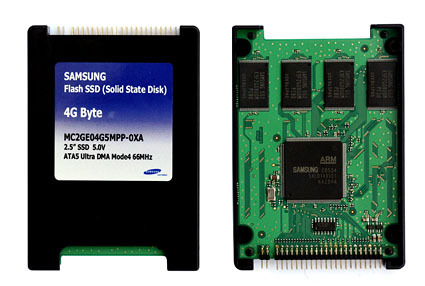Quo Vadis, Hard Drive? The 50th Anniversary of the HDD
Seagate does not believe in Flash-only drives like this Samsung prototype, but it sees Flash as an addition to conventional magnetic recording technologies.
Tom's Hardware Guide: Will the next generation hard disk drives rotate at higher speeds?
Atzkern: Today's 2.5" and 3.5" hard disk drive market uses rotation speeds in between of 5,400 and 15,000 RPM. It only makes sense to increase mechanical speeds if the market is finally saturated in a relevant segment. Higher rotation speeds have a very strong influence on the hard disk drive's energy intake. You have to keep this in mind with regard to integration into all sorts of systems. Also, distributing a large number of new products to the dealer as well as the customer entails logistical challenges and the trend goes towards smaller form factors. Speed can more easily be achieved by using two or more hard disk drives instead of higher rotation speeds.
Tom's Hardware Guide: How about performance increases in general? During the past few years, CPUs as well as graphics cards showed a tremendous increase in performance. At the same time, hard disk drives are still running at relatively slow transfer speeds and access times. Do you expect a performance impulse any time soon? If so, can you talk about technologies and their impact?
Atzkern: Introducing perpendicular recording resulted in a 25-30% increase with regard to the maximum transfer rates. Here's an example: The Cheetah 15K.4 with horizontal recording transfers data at a maximum of 94 MB/s. The new 15K.4 with perpendicular recording hits a maximum of 130 MB/s. This is clearly more than the common PCI Bus is able to transfer.
Tom's Hardware Guide: Is Flash memory a future competitor to the already existing recording technologies, or is it more of a supplement in your opinion?
Atzkern: In Seagate's eyes, flash memory is more of a supplement. Just recently, we introduced a hybrid hard disk that adds Flash memory to the classic hard disk drive concept. Being a combination of both worlds it is extremely efficient, allows the computer to boot faster and even more reliable.
Notebook manufacturers are continuously forced to look for a compromise: Higher performance usually results in bad battery life time. Power consumption can be reduced by combining low-current Flash memory and a fast hard disk drive. Therefore, the new Momentus 5400 PSD (power-saving drive) at 5,400 rpm duplicates data that is most frequently accessed into a 256 MB non-volatile cache. When turning on your laptop, the hard disk drive has to spin up first before the computer can actually boot. If you boot from a Flash memory, this delay does not apply any more. Our hybrid hard disk drive is 20% faster in resuming work than common models after returning from hibernation. That is because frequently used data is stored to the Flash cache before the system hibernates.
Get Tom's Hardware's best news and in-depth reviews, straight to your inbox.
Current page: Seagate does not believe in Flash-only drives like this Samsung prototype, but it sees Flash as an addition to conventional magnetic recording technologies.
Prev Page Quo Vadis, Hard Drive? The 50th Anniversary of the HDD